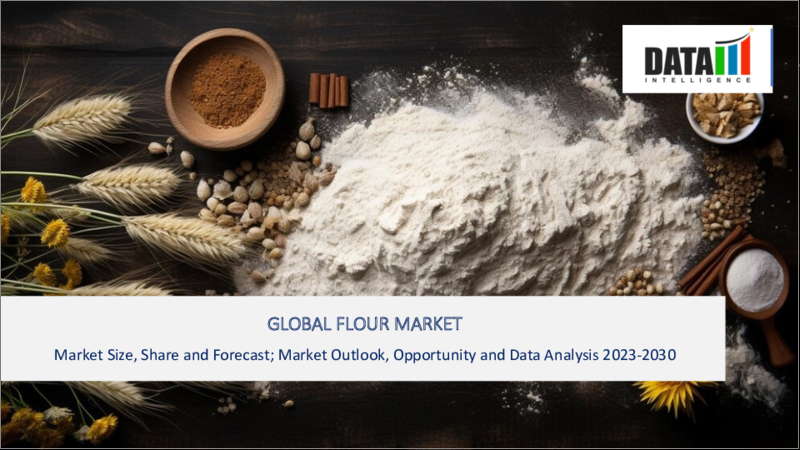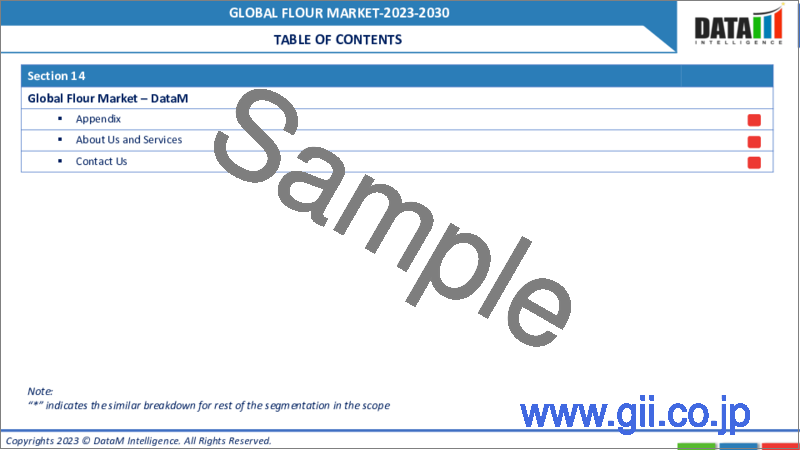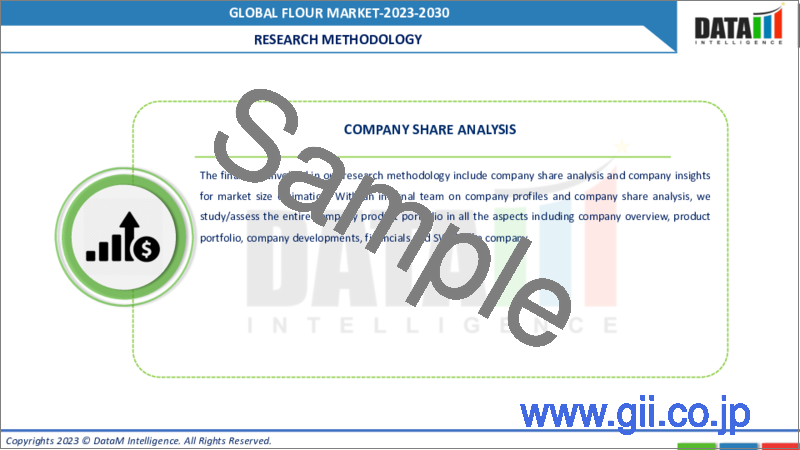|
|
市場調査レポート
商品コード
1290369
フラワー(穀物粉末)の世界市場-2023-2030Global Flour Market - 2023-2030 |
||||||
|
● お客様のご希望に応じて、既存データの加工や未掲載情報(例:国別セグメント)の追加などの対応が可能です。 詳細はお問い合わせください。 |
|||||||
| フラワー(穀物粉末)の世界市場-2023-2030 |
|
出版日: 2023年06月12日
発行: DataM Intelligence
ページ情報: 英文 190 Pages
納期: 約2営業日
|
- 全表示
- 概要
- 目次
市場概要
フラワー(穀物粉末)の世界市場は、2022年に1,555億米ドルに達し、2030年には最大2,385億米ドルに達することで有利な成長を示すと予測されます。同市場は予測期間中(2023年~2030年)に5.5%のCAGRを示すと予測されています。
強力粉は、パンやベーカリーグッズ、ファストフードや揚げ物に使用されるコーンベースのコーティングの成分です。ファストフード店ではドーナツ、ハンバーガー、ケーキ、肉のフライなどの食品が提供されるため、これらの店舗ではフラワー(穀物粉末)や全粒粉の消費量が多いのです。フラワー(穀物粉末)市場の需要は、人口の拡大や一人当たりの所得の増加により、フラワー(穀物粉末)の生産量が増加しています。
ファストフード製品の製造に使用される中力粉、強化フラワー(穀物粉末)、漂白フラワー(穀物粉末)の需要は、顧客の伝統的な生活から都会的で現代的な生活への移行に伴って増加しています。さらに、健康への関心の高まりから、無漂白フラワー(穀物粉末)やグルテンフリーの高タンパクフラワー(穀物粉末)の代替品への需要が高まっており、これが予測期間2023-2030年の世界フラワー(穀物粉末)市場の成長を牽引しています。
市場力学
人口増加、低所得国の生活水準の向上、迅速な購入のしやすさがフラワー(穀物粉末)市場の成長を後押しすると予想されます
信じられないことに、世界の人口は増え続けています。過去10年間で世界の人口は69億人から79億人に増加し、2050年には97億人が地球上に住むと予測されています。その結果、健康的な食料生産へのニーズが飛躍的に高まっています。一方、市場開拓の大きな原動力となっているのが、バングラデシュ、中国、インドネシア、インドといった低所得国の生活レベルの向上です。
中国の一人当たりGDPは、2022年12月時点で12,551ドルでした。同様に、バングラデシュの一人当たりGDP(PPP値)は5,733ドルであったのに対し、インドは2022年に7319ドル(PPP値)でした。一方、現代的な小売店の拡大や、フラワー(穀物粉末)ミックスのオンライン化が世界のフラワー(穀物粉末)市場動向を支えています。
環境大災害と土壌有機物含有量の減少が世界のフラワー(穀物粉末)市場の拡大を阻害すると予測される
世界各国は、経済成長のために環境資源を乱用し、地球の安全保障を弱体化させています。川は自然の流れから変えられ、木は切り倒されています。森林伐採による土壌浸食で土壌有機物が減少し、農地は狭くなっています。
さらに、気温の上昇により洪水が発生し、農業の収量が減少しています。さらに、フラワー(穀物粉末)を原料とする食品の需給ギャップの拡大、原油価格の高騰、紛争が続くロシア連邦への制裁などが、フラワー(穀物粉末)製品購入者の懐に負担を強いているのです。
COVID-19影響分析
COVID-19分析では、COVID前シナリオ、COVIDシナリオ、COVID後シナリオに加え、価格ダイナミクス(パンデミック発生時および発生後の価格変動をCOVID前シナリオと比較)、需要-供給スペクトラム(取引制限、封鎖およびその後の問題による需要と供給のシフト)、政府の取り組み(政府機関による市場、セクター、産業の活性化に関する取り組み)、メーカーの戦略的取り組み(メーカーによるCOVID問題を軽減するための取り組み)についても解説する予定です。
目次
第1章 調査手法とスコープ
- 調査手法
- 調査目的および調査範囲
第2章 市場の定義と概要
第3章 エグゼクティブサマリー
第4章 市場力学
- 市場影響因子
- 促進要因
- 抑制要因
- 機会
- 影響分析
第5章 産業分析
- ポーターのファイブフォース分析
- サプライチェーン分析
- 価格分析
- 法規制の分析
第6章 COVID-19の分析
第7章 製品タイプ別
- トウモロコシ
- 小麦
- ライ麦
- オート麦
- 米
- ひよこ豆
- その他
第8章 用途別
- 食品
- 飼料
- その他
第9章 流通チャネル別
- オフライン
- オンライン
第10章 エンドユーザー別
- 家庭用
- フードサービス事業者
第11章 地域別
- 北米
- 米国
- カナダ
- メキシコ
- 欧州
- ドイツ
- 英国
- フランス
- イタリア
- スペイン
- その他欧州
- 南米
- ブラジル
- アルゼンチン
- その他南米地域
- アジア太平洋地域
- 中国
- インド
- 日本
- オーストラリア
- その他アジア太平洋地域
- 中東・アフリカ地域
第12章 競合情勢
- 競合シナリオ
- 市況/シェア分析
- M&A(合併・買収)分析
第13章 企業プロファイル
- King Arthur Flour Company
- 会社概要
- 製品ポートフォリオと説明
- 財務概要
- 主な発展状況
- Ardent Mills
- Associated British Foods Plc
- Hindustan Unilever Ltd
- Archer Daniels Midland Company
- Hodgson Mill
- ConAgra Foods Inc
- Cargill
- ITC Ltd
- General Mills
第14章 付録
Market Overview
The Global Flour Market reached US$ 155.5 billion in 2022 and is projected to witness lucrative growth by reaching up to US$ 238.5 billion by 2030. The market is expected to exhibit a CAGR of 5.5% during the forecast period (2023-2030).
Flour is a component of bread, bakery goods, and the corn-based coating used on fast food and fried foods. Because fast food restaurants provide foods like doughnuts, burgers, cakes, and fried meat, there is a significant consumption of wheat flour and whole wheat at these establishments. The flour market demand has grown due to population expansion and rising per capita income, which has resulted in increasing flour production.
The demand for all-purpose flour, enriched flour, and bleached flour used in the manufacturing of fast-food products has risen as customers' traditional lives give way to urban and contemporary ones. Furthermore, the demand for unbleached flour and gluten-free alternatives to high-protein flour has increased because of growing health concerns, which is driving the global flour market growth during the forecast period 2023-2030.
Market Dynamics
Growing Population, Higher Living Standards in Low-Income Countries, and the Ease of Quick Purchases are Anticipated to Boost Flour Market Growth.
Incredibly, the world's population is growing. The world's population increased from 6.9 billion to 7.9 billion over the past ten years, and it is predicted that 9.7 billion people will live on Earth by the year 2050. As a result, there has been a dramatic increase in the need for healthy food production. On the other hand, a significant driving force behind the market development is the improving level of life in low-income nations like Bangladesh, China, Indonesia, and India.
China's GDP per capita was $12,551 in December 2022. In a similar vein, Bangladesh's GDP per capita (PPP values) was at $5,733 whereas India's was at $7319 (PPP terms) in 2022. On the other hand, the expanding number of contemporary retail establishments and online availability of flour mixes are supporting global flour market trends.
Environmental Catastrophes and Declining Soil Organic Content are Predicted to Impede Global Flour Market Expansion
Countries all around the world are weakening the security of this planet by overusing environmental resources in a misguided pursuit of economic growth. Rivers are being changed from their natural paths and trees are being chopped down. The agricultural area is getting smaller because of soil erosion caused by extensive deforestation, which is causing declination in soil organic matter.
Additionally, rising temperatures are causing devastating floods and decreasing agricultural yields overall. In addition, the growing gap between supply and demand for flour-based food, the skyrocketing cost of crude oil, and the sanctions placed on the Russian Federation due to the ongoing conflict are all adding to the burden on the pockets of flour product buyers.
COVID-19 Impact Analysis
The COVID-19 analysis includes Pre-COVID Scenario, COVID Scenario and Post-COVID Scenario along with pricing dynamics (including pricing change during and post-pandemic comparing it with pre-COVID scenarios), demand-supply spectrum (shift in demand and supply owing to trading restrictions, lockdown, and subsequent issues), government initiatives (initiatives to revive market, sector or industry by government bodies) and manufacturers strategic initiatives (what manufacturers did to mitigate the COVID issues will be covered here).
Segment Analysis
The global flour market is segmented based on product type, application, distribution channel, end-user, and region.
In the Global Market of Flour, the Offline Segment Holds the Largest Market Share
The global flour market has been segmented by distribution channel into offline and online. The offline segment held the largest flour market share of 59.4% in 2022 in the flour market analysis report. The growth is attributable to offline retail shops' many benefits, including the way they foster a human connection between customers and businesses. Customers always choose to purchase on offline platforms as a result.
Additionally, they provide customers the chance to physically handle and feel the items at the moment of purchase, allowing them to discover the hidden flaws if any. Moreover, buyers are drawn to offline retail establishments because of their rapid purchase and sales support capabilities. Furthermore, contemporary retailers are making their way into certain rural regions in an effort to capitalize on the untapped potential.
Geographical Analysis
The Asia-Pacific Held the Largest Share in Flour Market in 2022
The global flour market is segmented into North America, South America, Europe, Asia Pacific, the Middle East, and Africa. The Asia-Pacific flour market held the largest market share of 42.6% in 2022 in the flour market analysis.
The demand for bread flour, cake flour, and pastry flour coupled with increasing demand for gluten-free flour substitutes such as enriched flour like maize flour, rice flour, soy flour,and corn flour has increased as a result of rising health concerns about high-protein flour. Due to less onerous rules of government supervision on the flour sector, private flour millers in Asia-Pacific have prompted private companies to boost their production capacity and creative product offers.
Additionally, India produces close to 8 million tonnes of garbanzo beans annually, accounting for around 68-70% of global production. Australia, the second-largest producer, accounts for over 10% of the world's output of chickpeas. The region's flour market growth is brought on by an increase in disposable income, a growing population, and improved retail infrastructure.
Competitive Landscape
The major global players in the market include: Ardent Mills, Associated British Foods Plc, King Arthur Flour Company, Archer Daniels Midland Company, Hindustan Unilever Ltd., Hodgson Mill, Cargill, ITC Ltd., ConAgra Foods Inc., and General Mills.
Global Recession/Ukraine-Russia War/COVID-19, and Artificial Intelligence Impact Analysis:
COVID-19 Impact:
The COVID-19 pandemic in 2020 resulted in the greatest worldwide economic recession ever. Globally, the epidemic has had a severe impact on the economy. The COVID-19 problem has caused a 4.2% decline in the world's GDP. The coronavirus outbreak has also been disrupting the world's food supply and agri-food value chains. The fast spread of COVID-19 put difficult decisions on the world's decision-makers.
As many nations adopted the required social segregation measures in reaction to the epidemic, a unique and complex situation developed. Numerous nations confronted numerous difficulties regarding the economy, food security, and public health. Primary production, processing, commerce, logistics, and demand are all impacted by agriculture and food.
The logistics of the food value chain have been impacted, as well as the flow of agricultural inputs, outputs, and services associated with agriculture, because of the global movement restrictions and border closures enacted to manage the epidemic. Global food markets were well-balanced despite the worries brought on by the fast spread of COVID-19 over the world.
While the pandemic caused a 7 percent decline in the global commodities trade in 2020, the flour and bread goods sector survived a significant test. Due to the rising demand for staple foods like flour, pasta, and pulses as well as the general state of panic, the market shelves were notably bare during the start of the epidemic. However, because of the robust dynamics of the domestic and international markets, it was possible to restock the shelves quickly and ensure that no one was left without items because of the epidemic.
Why Purchase the Report?
- To visualize the global flour market segmentation based on product type, application, distribution channel, end-user, and region, as well as understand key commercial assets and players.
- Identify commercial opportunities in the market by analyzing trends and co-development.
- Excel data sheet with numerous data points of flour market-level with all segments.
- The PDF report consists of cogently put-together market analysis after exhaustive qualitative interviews and in-depth market study.
- Product mapping is available as Excel consists of key products of all the major market players.
The global flour market report would provide approximately 93 tables, 109 figures and 190 Pages.
Target Audience 2023
- Manufacturers/ Buyers
- Industry Investors/Investment Bankers
- Research Professionals
- Emerging Companies
Table of Contents
1. Methodology and Scope
- 1.1. Research Methodology
- 1.2. Research Objective and Scope of the Report
2. Market Definition and Overview
3. Executive Summary
- 3.1. Market Snippet, by Product Type
- 3.2. Market Snippet, by Application
- 3.3. Market Snippet, by Distribution Channel
- 3.4. Market Snippet, by End-User
- 3.5. Market Snippet, by Region
4. Market Dynamics
- 4.1. Market Impacting Factors
- 4.1.1. Drivers
- 4.1.2. Restraints
- 4.1.3. Opportunity
- 4.1.4. Impact Analysis
5. Industry Analysis
- 5.1. Porter's Five Force Analysis
- 5.2. Supply Chain Analysis
- 5.3. Pricing Analysis
- 5.4. Regulatory Analysis
6. COVID-19 Analysis
- 6.1. Analysis of COVID-19 on the Market
- 6.1.1. Scenario Before COVID-19
- 6.1.2. Scenario During COVID-19
- 6.1.3. Scenario Post COVID-19
- 6.2. Pricing Dynamics Amid COVID-19
- 6.3. Demand-Supply Spectrum
- 6.4. Government Initiatives Related to the Market During Pandemic
- 6.5. Manufacturers Strategic Initiatives
- 6.6. Conclusion
7. By Product Type
- 7.1. Introduction
- 7.1.1. Market Size Analysis and Y-o-Y Growth Analysis (%), By Product Type
- 7.1.2. Market Attractiveness Index, By Product Type
- 7.2. Maize*
- 7.2.1. Introduction
- 7.2.2. Market Size Analysis and Y-o-Y Growth Analysis (%)
- 7.3. Wheat
- 7.4. Rye
- 7.5. Oat
- 7.6. Rice
- 7.7. Chickpea
- 7.8. Others
8. By Application
- 8.1. Introduction
- 8.1.1. Market Size Analysis and Y-o-Y Growth Analysis (%), By Application
- 8.1.2. Market Attractiveness Index, By Application
- 8.2. Food*
- 8.2.1. Introduction
- 8.2.2. Market Size Analysis and Y-o-Y Growth Analysis (%)
- 8.3. Feed
- 8.4. Others
9. By Distribution channel
- 9.1. Introduction
- 9.1.1. Market Size Analysis and Y-o-Y Growth Analysis (%), By Distribution channel
- 9.1.2. Market Attractiveness Index, By Distribution channel
- 9.2. Offline*
- 9.2.1. Introduction
- 9.2.2. Market Size Analysis and Y-o-Y Growth Analysis (%)
- 9.3. Online
10. By End-User
- 10.1. Introduction
- 10.1.1. Market Size Analysis and Y-o-Y Growth Analysis (%), By End-User
- 10.1.2. Market Attractiveness Index, By End-User
- 10.2. Households
- 10.2.1. Introduction
- 10.2.2. Market Size Analysis and Y-o-Y Growth Analysis (%)
- 10.3. Food Service Provider
11. By Region
- 11.1. Introduction
- 11.1.1. Market Size Analysis and Y-o-Y Growth Analysis (%), By Region
- 11.1.2. Market Attractiveness Index, By Region
- 11.2. North America
- 11.2.1. Introduction
- 11.2.2. Key Region-Specific Dynamics
- 11.2.3. Market Size Analysis and Y-o-Y Growth Analysis (%), By Product Type
- 11.2.4. Market Size Analysis and Y-o-Y Growth Analysis (%), By Application
- 11.2.5. Market Size Analysis and Y-o-Y Growth Analysis (%), By Distribution Channel
- 11.2.6. Market Size Analysis and Y-o-Y Growth Analysis (%), By End-User
- 11.2.7. Market Size Analysis and Y-o-Y Growth Analysis (%), By Country
- 11.2.7.1. The U.S.
- 11.2.7.2. Canada
- 11.2.7.3. Mexico
- 11.3. Europe
- 11.3.1. Introduction
- 11.3.2. Key Region-Specific Dynamics
- 11.3.3. Market Size Analysis and Y-o-Y Growth Analysis (%), By Product Type
- 11.3.4. Market Size Analysis and Y-o-Y Growth Analysis (%), By Application
- 11.3.5. Market Size Analysis and Y-o-Y Growth Analysis (%), By Distribution Channel
- 11.3.6. Market Size Analysis and Y-o-Y Growth Analysis (%), By End-User
- 11.3.7. Market Size Analysis and Y-o-Y Growth Analysis (%), By Country
- 11.3.7.1. Germany
- 11.3.7.2. The U.K.
- 11.3.7.3. France
- 11.3.7.4. Italy
- 11.3.7.5. Spain
- 11.3.7.6. Rest of Europe
- 11.4. South America
- 11.4.1. Introduction
- 11.4.2. Key Region-Specific Dynamics
- 11.4.3. Market Size Analysis and Y-o-Y Growth Analysis (%), By Product Type
- 11.4.4. Market Size Analysis and Y-o-Y Growth Analysis (%), By Application
- 11.4.5. Market Size Analysis and Y-o-Y Growth Analysis (%), By Distribution Channel
- 11.4.6. Market Size Analysis and Y-o-Y Growth Analysis (%), By End-User
- 11.4.7. Market Size Analysis and Y-o-Y Growth Analysis (%), By Country
- 11.4.7.1. Brazil
- 11.4.7.2. Argentina
- 11.4.7.3. Rest of South America
- 11.5. Asia-Pacific
- 11.5.1. Introduction
- 11.5.2. Key Region-Specific Dynamics
- 11.5.3. Market Size Analysis and Y-o-Y Growth Analysis (%), By Product Type
- 11.5.4. Market Size Analysis and Y-o-Y Growth Analysis (%), By Application
- 11.5.5. Market Size Analysis and Y-o-Y Growth Analysis (%), By Distribution Channel
- 11.5.6. Market Size Analysis and Y-o-Y Growth Analysis (%), By End-User
- 11.5.7. Market Size Analysis and Y-o-Y Growth Analysis (%), By Country
- 11.5.7.1. China
- 11.5.7.2. India
- 11.5.7.3. Japan
- 11.5.7.4. Australia
- 11.5.7.5. Rest of Asia-Pacific
- 11.6. Middle East and Africa
- 11.6.1. Introduction
- 11.6.2. Key Region-Specific Dynamics
- 11.6.3. Market Size Analysis and Y-o-Y Growth Analysis (%), By Product Type
- 11.6.4. Market Size Analysis and Y-o-Y Growth Analysis (%), By Application
- 11.6.5. Market Size Analysis and Y-o-Y Growth Analysis (%), By Distribution Channel
- 11.6.6. Market Size Analysis and Y-o-Y Growth Analysis (%), By End-User
12. Competitive Landscape
- 12.1. Competitive Scenario
- 12.2. Market Positioning/Share Analysis
- 12.3. Mergers and Acquisitions Analysis
13. Company Profiles
- 13.1. King Arthur Flour Company
- 13.1.1. Company Overview
- 13.1.2. Product Portfolio and Description
- 13.1.3. Financial Overview
- 13.1.4. Key Developments
- 13.2. Ardent Mills
- 13.3. Associated British Foods Plc
- 13.4. Hindustan Unilever Ltd
- 13.5. Archer Daniels Midland Company
- 13.6. Hodgson Mill
- 13.7. ConAgra Foods Inc
- 13.8. Cargill
- 13.9. ITC Ltd
- 13.10. General Mills
LIST NOT EXHAUSTIVE
14. Appendix
- 14.1. About Us and Services
- 14.2. Contact Us




